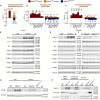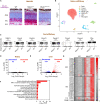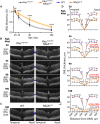Overexpression of Nfe2l1 increases proteasome activity and delays vision loss in a preclinical model of human blindness
- PMID: 37450596
- PMCID: PMC10348684
- DOI: 10.1126/sciadv.add5479
Overexpression of Nfe2l1 increases proteasome activity and delays vision loss in a preclinical model of human blindness
Abstract
Proteasomes are the central proteolytic machines that are critical for breaking down most of the damaged and abnormal proteins in human cells. Although universally applicable drugs are not yet available, the stimulation of proteasomal activity is being analyzed as a proof-of-principle strategy to increase cellular resistance to a broad range of proteotoxic stressors. These approaches have included the stimulation of proteasomes through the overexpression of individual proteasome subunits, phosphorylation, or conformational changes induced by small molecules or peptides. In contrast to these approaches, we evaluated a transcription-driven increase in the total proteasome pool to enhance the proteolytic capacity of degenerating retinal neurons. We show that overexpression of nuclear factor erythroid-2-like 1 (Nfe2l1) transcription factor stimulated proteasome biogenesis and activity, improved the clearance of the ubiquitin-proteasomal reporter, and delayed photoreceptor neuron loss in a preclinical mouse model of human blindness caused by misfolded proteins. The findings highlight Nfe2l1 as an emerging therapeutic target to treat neurodegenerative diseases linked to protein misfolding.
Figures







References
-
- M. S. Hipp, P. Kasturi, F. U. Hartl, The proteostasis network and its decline in ageing. Nat. Rev. Mol. Cell Biol. 20, 421–435 (2019). - PubMed
MeSH terms
Substances
Grants and funding
LinkOut - more resources
Full Text Sources
Molecular Biology Databases
Research Materials

